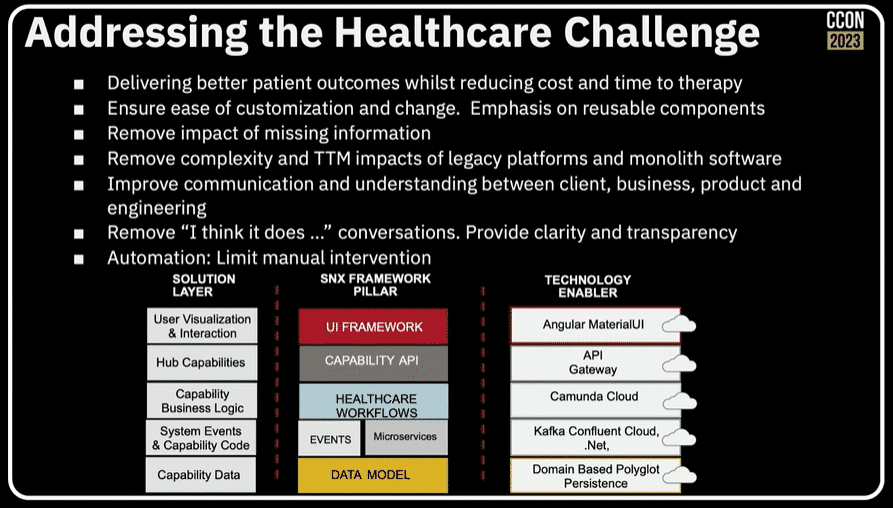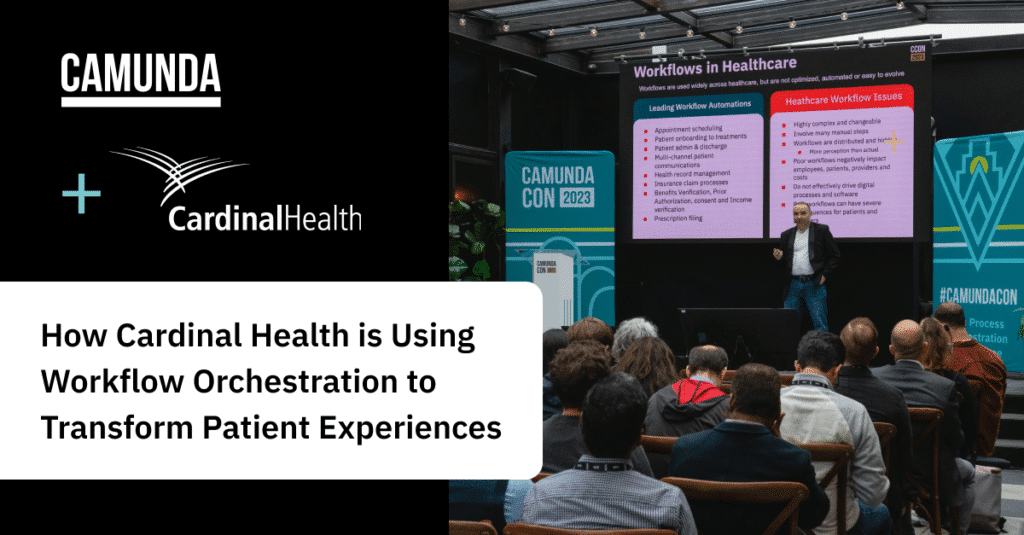Connecting patients to the care they need
Cardinal Health is on a mission to deliver products and end-to-end solutions that improve people’s lives and do it in a way that streamlines systems and enhances patients’ experiences. Their Sonexus subdivision, for example, helps simplify and expedite access to life-changing therapies for underinsured or uninsured people.
But, as Steven Gregory, Director of Commercial Software, explained to the audience at CamundaCon 2023, internal and external factors present constant challenges in the healthcare industry. Changing regulations, privacy concerns, manual processes, a lot of legacy code, and an industry where the fax machine is still the leading technology are just a few of the roadblocks to developing standard processes that work across systems and vendors. And, of course, organizations across the industry are under constant pressure to deliver better health outcomes in a faster, more cost-efficient way.
That’s why, to more easily connect patients to the care they need, Steven and his team are building scalable, automated processes and re-architecting legacy systems around reusable microservices. Every process is part of a patient journey—from the initial diagnosis, to the shipping of specialty therapeutic drugs, to tracking delivery to the patient. The quality of that journey can affect a patient’s health outcome. As Steve describes it, for Sonexus patients, “Our job is all about the patient journey. If we fail, we’ve got somebody who really needs these drugs to have a better quality of life, and they’re not getting it.”
Starting with workflows
To improve patient journeys, Steven’s team turned to Camunda. “Healthcare is a very workflow-driven industry,” says Steven. However, most healthcare workflows exist only in code or are highly manual, which means they are not optimized, automated, or easy to evolve. As Steven tells it, “The first thing we did with Camunda when engineering launched [it] is, we gave it straight over to our product teams and our business teams and said, ‘We don’t start delivering software ‘til you’ve written these workflows’ … The beauty of Camunda, it’s simple. It’s BPMN notation. It’s easy to learn. My product people, my business people learned it in a matter of weeks and started going and playing with it.”
Using Camunda, Steven’s team is bringing visibility and clarity to Sonexus workflows and embracing customization. “This is really where Camunda comes into play for what we need to do,” says Steven. “Because we need to be able to see what we’ve got and how quickly we can change it for different programs and patients.”
The value of building workflows in Camunda using BPMN is that once the workflows are designed, Steven and team can then sit with internal clients, review what they’ve built, discuss how to change and optimize, and plug those workflow changes into Sonexus’s Kafka-powered, event-driven architecture. “We look at those as microservices, as well, to an extent that they’re reusable, autonomous blocks that we can plug and play together to create new things,” explains Steven, “…our Camunda implementation is very hierarchical so we can plug and play and change and adapt things quickly.”
Tying it all together

“The first program we’re actually rolling out is the patient assistance program, so we can get the non-insured people onto [therapeutic] drugs quickly,” shared Steven. To do that, the Sonexus team is building out workflows to automate enrollment steps, such as benefits verification, income verification, co-pay, prior authorization, and appointment scheduling for a new, digital enrollment form solution. They are also working on an optical character recognition-related solution that helps speed enrollments by fax.
On the backend, the team is working on tying Camunda workflows to the backend software as one, extensible, plug and play architecture. “We have a tight integration with our Kafka solution for events to drive it,” said Steven, “and we use SignalR, which is a WebSocket for our communication with our UI components.” Once completed, the event-driven architecture will allow Sonexus to make changes on the fly and deliver to customers, which will reduce time to market and costs for their big pharma clients.
Building toward success
Through the adoption and use of Camunda, Sonexus is changing their culture and the way their teams think. “Camunda’s far more than an engineering workflow orchestration tool,” says Steven. “It’s the enabler to change how people think, how you build software, and how you work together.”
With Camunda, Sonexus is also changing how they build software solutions. Steven describes how, in the early days, the team used Camunda to map out existing processes. “What we were doing were just reinventing the processes we’d already got in place. We weren’t looking at optimizing the processes and creating new ways to do things. So, that’s why, again, I can’t stress enough, build your processes the way they need to be, not the way your solution forces you to go.”
That includes building for user experience. Sonexus involves their patient experience team from day one to help create a very easy and repeatable user experience for their clients. Steven’s other insights for success with Camunda include:
- Start with a proof of concept involving all related roles of the business
- Ensure solution architecture can be easily extended to support microservice orchestration
- Build a community of practice
- Plan for transition of existing logic
- Do not boil the ocean. Identify areas of value that are easy to execute. Get a win!
- Get workflows out there and iterate
- Functionally decompose workflows. Create a hierarchy.
Additionally, Steven advises keeping the business logic pure so your organization can adapt to change quickly.
Affecting change
“We’re convinced Camunda is our solution going forward.”
The Sonexus team is working on completing the rollout of their planned programs for the Sonexus hub and building out an architecture fully around microservices and events driven through Kafka. Over the next year, their goal is to process 20% of all cases without manual intervention. According to Steven, “Once we can show 20%, it encourages providers and manufacturers to change their behaviors because they’ve started to see some benefits and a solution to get to where we want to go.”
They’re also collaborating on the design of new workflows to support new, regulated therapies, such as cell and gene therapy. “It’s a new industry or sub-industry of healthcare, so no one can actually tell you what the process is yet, “ says Steven. “One of the big areas at Cardinal we’re looking at, and within the Sonexus division, is how Camunda can really be that centralized organizing software, that process orchestration, that workflow orchestration to control all this complex, monitoring, shipping, and everything else that’s going on in this cell and gene therapy journey.”
Learn more
Watch the full replay to hear Steven’s take on trends driving change in the healthcare industry and Sonexus’s approach to building workflows for new, regulated therapies, such as cell and gene therapy.
Learn more about Camunda process orchestration.


Start the discussion at forum.camunda.io